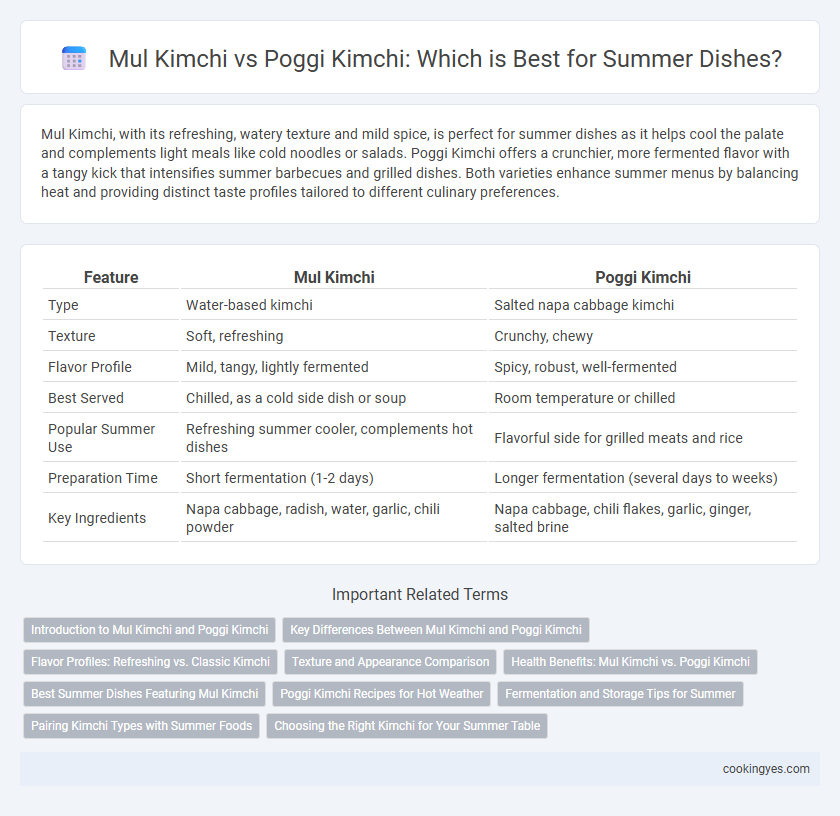Mul Kimchi, with its refreshing, watery texture and mild spice, is perfect for summer dishes as it helps cool the palate and complements light meals like cold noodles or salads. Poggi Kimchi offers a crunchier, more fermented flavor with a tangy kick that intensifies summer barbecues and grilled dishes. Both varieties enhance summer menus by balancing heat and providing distinct taste profiles tailored to different culinary preferences.
Table of Comparison
| Feature | Mul Kimchi | Poggi Kimchi |
|---|---|---|
| Type | Water-based kimchi | Salted napa cabbage kimchi |
| Texture | Soft, refreshing | Crunchy, chewy |
| Flavor Profile | Mild, tangy, lightly fermented | Spicy, robust, well-fermented |
| Best Served | Chilled, as a cold side dish or soup | Room temperature or chilled |
| Popular Summer Use | Refreshing summer cooler, complements hot dishes | Flavorful side for grilled meats and rice |
| Preparation Time | Short fermentation (1-2 days) | Longer fermentation (several days to weeks) |
| Key Ingredients | Napa cabbage, radish, water, garlic, chili powder | Napa cabbage, chili flakes, garlic, ginger, salted brine |
Introduction to Mul Kimchi and Poggi Kimchi
Mul Kimchi, also known as watery kimchi, is a refreshing Korean side dish characterized by its cool, tangy, and mild flavor, making it ideal for summer consumption. Poggi Kimchi, or traditional fermented cabbage kimchi, offers a spicier and more robust taste with a thicker, crunchier texture. Both types provide essential probiotics and vitamins, but Mul Kimchi's liquid-based form is particularly effective for hydration and cooling during hot weather.
Key Differences Between Mul Kimchi and Poggi Kimchi
Mul Kimchi, a watery, mild, and refreshing Korean fermented cabbage dish, is ideal for cooling summer meals due to its crisp texture and light flavor. Poggi Kimchi, also known as Baechu Kimchi, is saltier and more pungent with a dense, spicy seasoning, providing a bold contrast in taste and aroma. The primary differences lie in Mul Kimchi's high water content and subtle seasoning versus Poggi Kimchi's robust fermentation and intense flavor profile.
Flavor Profiles: Refreshing vs. Classic Kimchi
Mul Kimchi offers a refreshing, mild flavor with its watery, slightly sweet brine that cools the palate, making it ideal for summer dishes. Poggi Kimchi features a classic, robust, and spicy profile with fermented napa cabbage and bold seasonings that provide depth and heat. The contrast between Mul Kimchi's light crispness and Poggi Kimchi's intense umami enriches a variety of seasonal meals.
Texture and Appearance Comparison
Mul Kimchi features a watery, translucent texture with crisp, thinly sliced vegetables that provide a refreshing crunch, ideal for cooling summer dishes. Poggi Kimchi offers a denser, opaque appearance with thicker cabbage layers and a robust, slightly chewy texture, delivering a heartier bite. The visual contrast highlights Mul Kimchi's lightness against Poggi Kimchi's richness, influencing their suitability for different summer meal pairings.
Health Benefits: Mul Kimchi vs. Poggi Kimchi
Mul Kimchi, a watery and mild variant, offers probiotics that aid digestion and hydration during hot summer months. Poggi Kimchi, fermented with spicy seasoning, provides higher levels of antioxidants and capsaicin, which can boost metabolism and improve circulation. Both types support gut health effectively but differ in their intensity and specific nutrient profiles beneficial for summer wellness.
Best Summer Dishes Featuring Mul Kimchi
Mul Kimchi, a refreshing water-based Korean kimchi, is ideal for summer dishes due to its light, tangy flavor and high hydration content, perfect for combating heat. It pairs excellently with cold noodles like naengmyeon and chilled tofu salads, providing a crisp, cooling contrast. The rich probiotic qualities of Mul Kimchi enhance digestion, making it a healthy complement for summer meals.
Poggi Kimchi Recipes for Hot Weather
Poggi Kimchi, characterized by its less fermented and lighter flavor, is ideal for hot weather as it offers a refreshing and crisp texture, complementing summer dishes without overpowering them. Recipes for Poggi Kimchi often include fresh cabbage, radish, green onions, garlic, and a mild gochugaru seasoning, making it a cooling, hydrating side dish perfect for balancing spicy grilled meats or cold noodles. Compared to the watery Mul Kimchi, Poggi Kimchi provides a heartier bite and more pronounced crunch, enhancing the sensory experience of summer meals while aiding digestion in high temperatures.
Fermentation and Storage Tips for Summer
Mul Kimchi, a watery, mild kimchi, ferments faster in warm summer temperatures due to its higher moisture content, making it ideal for quick consumption and refreshing summer dishes. Poggi Kimchi, with its denser texture and stronger flavors, requires longer fermentation and cooler storage to prevent over-fermentation during hot months, preserving its crispy crunch and complex taste. Storing both types in airtight containers at 4-7degC slows fermentation, maintaining optimal flavor and safety for summer enjoyment.
Pairing Kimchi Types with Summer Foods
Mul Kimchi, a watery and mild variety, pairs well with refreshing summer dishes such as cold noodles, seafood, and light salads because its subtle flavors and crisp texture complement and enhance delicate ingredients. Poggi Kimchi, being spicier and more fermented, suits grilled meats, hearty rice bowls, and robust vegetable dishes by adding heat and depth that balance richer flavors. Choosing between Mul and Poggi Kimchi depends on whether the summer dish benefits from a cooling contrast or a bold, tangy kick.
Choosing the Right Kimchi for Your Summer Table
Mul Kimchi, a water-based kimchi with mild, refreshing flavors, offers a cooling effect ideal for hot summer days and pairs well with light, delicate summer dishes. Poggi Kimchi, known for its spicy and crunchy texture, adds a bold, robust flavor that complements richer, grilled foods typically enjoyed during summer barbecues. Selecting Mul Kimchi or Poggi Kimchi depends on the balance of your summer menu, where Mul Kimchi suits mild dishes and Poggi Kimchi enhances bold, savory flavors.
Mul Kimchi vs Poggi Kimchi for Summer Dishes Infographic

 cookingyes.com
cookingyes.com